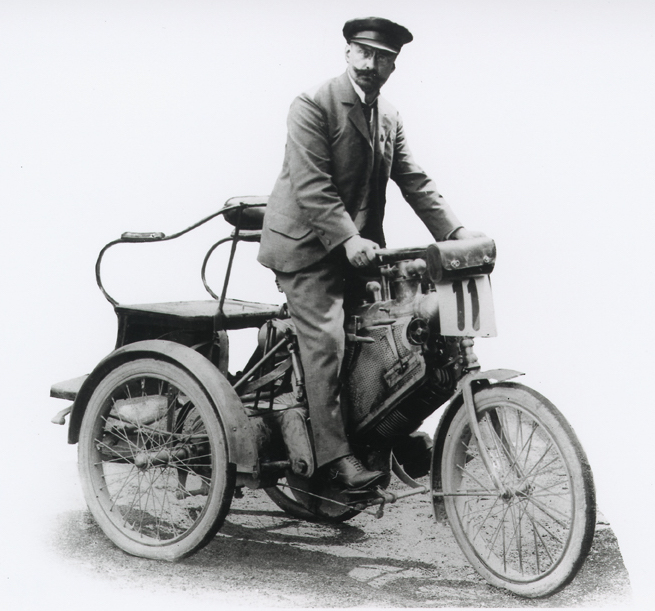Transportation isn’t a simple gas up and go, point A to point B equation anymore. Now cars drive themselves, travel for hundreds of miles without gas, and soon won’t have a steering wheel at all. And though the future of transportation is currently obsessed with humanity’s conveyance of choice—the automobile—motorcycles and scooters will play a big role as cities grow denser and green living transitions from a fringe lifestyle to federal law.FUTURE-PROOFING THE MODERN MOTORCYCLE, by ‘The Current’ editor Michael Wilson

To catch a glimpse of this future, Bosch flew me out to the green hills of the German countryside to visit its Mobility Solutions Proving Grounds in Boxberg. Although you’ve never ridden a Bosch-branded motorcycle, it’s more than likely that you’ve seen a bike being secretly powered by Bosch. The company even provided parts for some of the very first bikes, including a low-voltage magneto ignition device, created in 1897, for the electric-igntion De Dion-Bouton tricycle, the most successful European motor vehicle in the late 19th century.

But despite their 150-year history, motorcycles have lots of room to grow. Nearly 750 people die in motorcycle accidents every day, riders are 18 percent more vulnerable to accidents than drivers, and nine out ten motorcycle accidents are due to human error. Bosch is trying to shrink those numbers through technology that could find its way into millions of future bikes. Here’s how they’re going to do it.
The Best Rider is a Safe Rider
Motorcycles, by design, leave their rider exposed to accidents due to the physics of where the rubber meets the road, so how can technology improve what seems like an inherent flaw? Try making the bike smarter, starting with an anti-lock braking system. One of the first things any new rider learns is not to use the brakes in a corner because it reduces traction and can result in a low-side crash. It’s not a good situation, and it can be a fatal one, leading to the majority of motorcycle accidents every year.
But Bosch is trying to make this fatal tendency a thing of the past. With advanced monitoring units, they can compute lean angle, speed, and position, so if you need to hit the brakes when Bambi darts out into the road, you’ll maintain traction, and most importantly, not die. “If you look at the technology that has been used in cars over the last 20 years, you can see a definite trend of fatalities decreasing over time,” Bosch’s Tony Szczotka told The Vintagent. “That trend isn’t the same for motorcycles because the technology has only now started to show up.” When Bosch applies this same ABS technology sans curve, it triggers what the engineers lovingly call the rear wheel lift mitigation system, basically a very German way of saying a “stoppie” stopper. You’ve likely seen this pro-level motorcycle trick before, a rider lifts the back wheel off the ground while coming to a slow rolling stop—Bosch’s tech eliminates this completely.

I watched former AMA Superbike racer Mark Miller try to peel his back wheel off the pavement on an Aprilla Tuono, but it just didn’t happen. The bike wouldn’t let him. These same stability control sensors also serve a helpful function when a rider is stopped on hill. Heavier bikes can be hard to keep from rolling on steep inclines when adjusting something on your helmet or jacket. The Hill Hold Control will active when the Initial Measurement Unit receives a longitudinal signal greater than 10 percent, the gear position isn’t in neutral, and the engine is running. Ranging from 5-9 seconds, this control offers just enough time to fiddle with whatever you’re doing and get back to riding.
Related Posts
July 8, 2017
The Vintagent Trailers: Mancini, The Motorcycle Wizard
The mechanic that helped debut five of…




To quote engineers from BMW/MINI , Daimler Mercedes , Toyota/Lexus , Honda/Acura , VW-Audi-Porsche , PSA Nissan/Renault/Infinit etc et al ..
There is no viable future for EV’s of any kind . Period
Or to put a popular culture spin on it ‘ The answer my friend … is blowin in the wind .. and the answer is hydrogen ‘
So lets not go down the trendy wendy rabbit hole of pretense and delusion with EV motorcycles . Its a red herring .
You mean these engineers?
https://www.nytimes.com/2017/10/02/business/general-motors-electric-cars.html
https://www.theguardian.com/business/2017/sep/07/jaguar-land-rover-electric-hybrid-cars-2020
https://www.theguardian.com/business/2017/jul/05/volvo-cars-electric-hybrid-2019
Oh, please.
Everyone knows “Real men don’t use batteries! Real men set things on FIRE!!!” So give it a rest.
I find the typographical errors in this article distracting and detract from my reading pleasure.